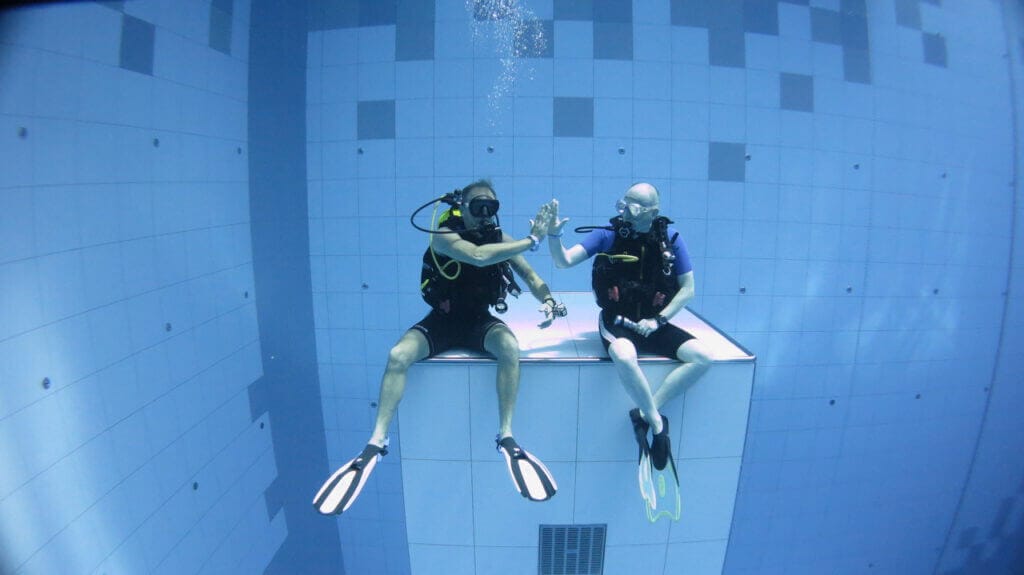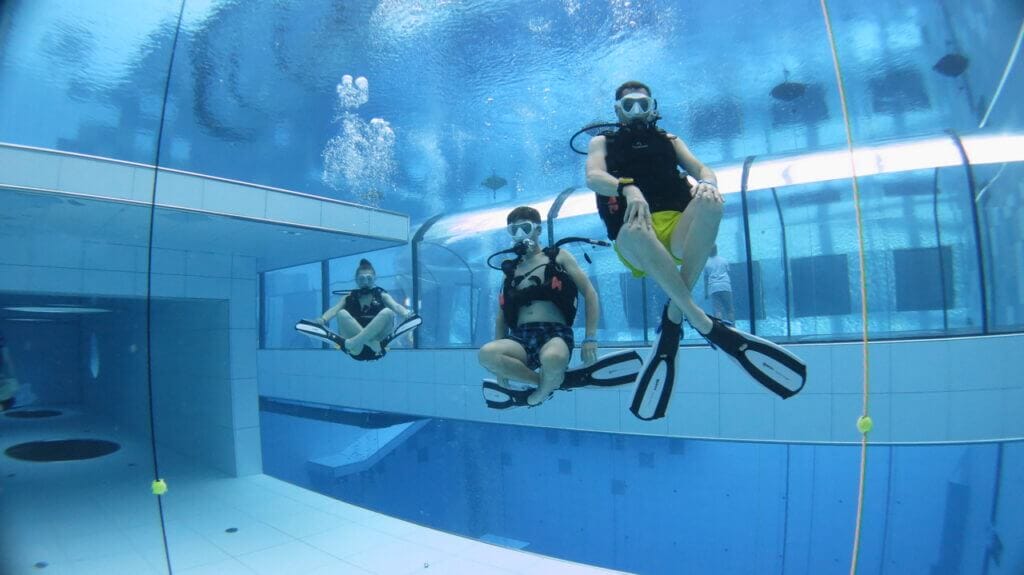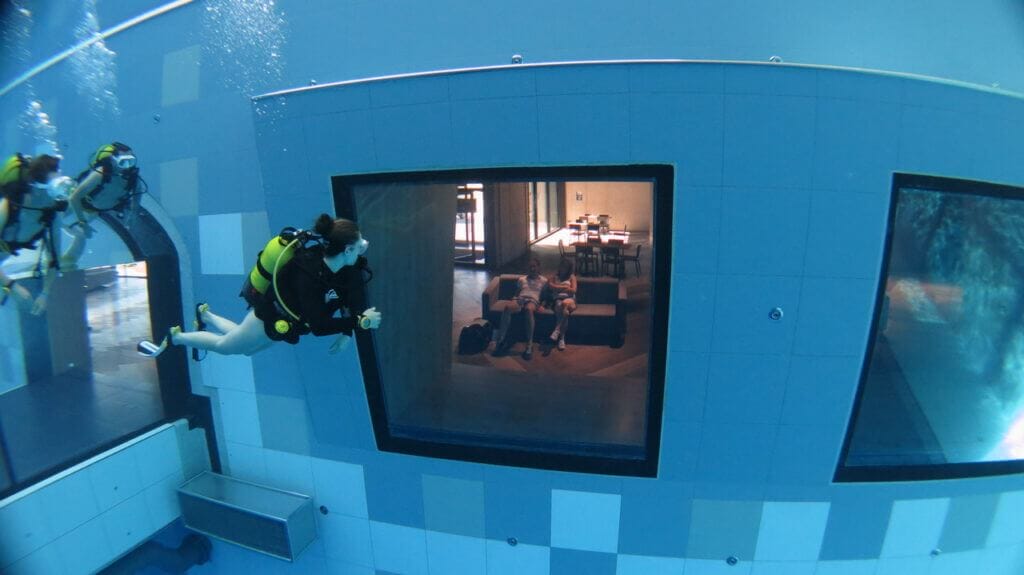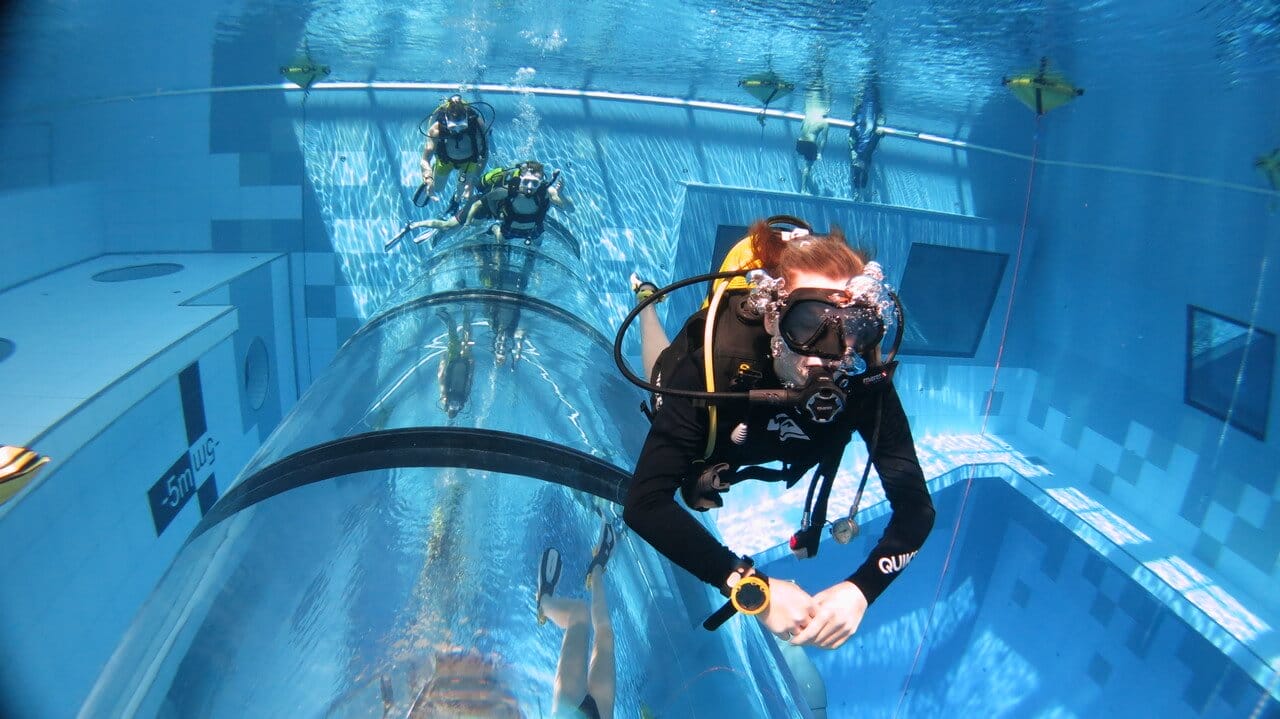If asked what paradise on earth looks like, you will probably hear a story about a deserted tropical island. Blue water and coral reefs. Wrecks and powerful fish. White sand and palm trees. Each of us is familiar with such views from the cinema, but one day we decide that this must change, and if you are reading this text it probably applies to you as well. All we have to do is decide with some determination that for us all these sights will one day become a beautiful but familiar world. A pub under palm trees on a sandy shore will be the place where we and our dive partners will discuss the newly discovered reef while planning the next day’s dives. Over coffee with coconut milk, we will discuss the possibility of seeing any of the beautiful underwater creatures. After many years of diving, we will have collected snapshots of such sites. Names such as Dahab, Vis, L’Estartit, Sipadan, Scapa Flow, St. Lucia, and St. Vincent. St. John’s, Truk, Diamont Rock, Cocos Island, will evoke beautiful dives in the memory.
We will recall Mantas, Dolphins and Sharks and, most importantly, interesting people met at dive bases. However, in order for this to happen, it is necessary to take the first step which is to obtain a diving “license” i.e. obtain a diving certificate after the Open Water Diver course. We go suddenly from dreams to the mundane of life, but that’s the way it is, first the fantasies and then the sting of excess baggage at check-in. To dive you have to learn it. Whether you’ve already started your diving adventure with Intra in Egypt, the Indoor program at Deepspot or you’re throwing yourself into the deep end right away, there’s a course for becoming an independent diver ahead of you – the aforementioned OWD course.
Such a course is several thousand zlotys, several days of training and several liters of water drunk by the nose. A few thousand zlotys is the minimum, the rest of the expenses – it depends – may come out a little more than a few.

Learning the theory
Whether it is the Open Water Diver course of the PADI organization or the OWD of the SSI organization we will start with learning in the form of an online course.
We want to go to the water and here they make us sit in front of the computer. However, during several parts of the online course, we watch a video explaining diving theory, describing equipment and basic diving skills. We answer dozens of review questions and pass the exam.
As part of the theory, we learn that divers do not breathe oxygen from their cylinders but normal air. We will learn how to use a special dive computer (such a larger wristwatch) to plan dives in such a way that we do not have to do decompression. We will learn how pressure changes with depth and how this affects our body. We will learn what the narcosis of the deep means and how water affects color vision or the size of objects underwater – very useful if we want to take photos or underwater videos. After online training, we will know more, but what is especially important is that we will understand what the instructor is explaining to us before the dive, or why certain exercises or certain underwater procedures are so important.
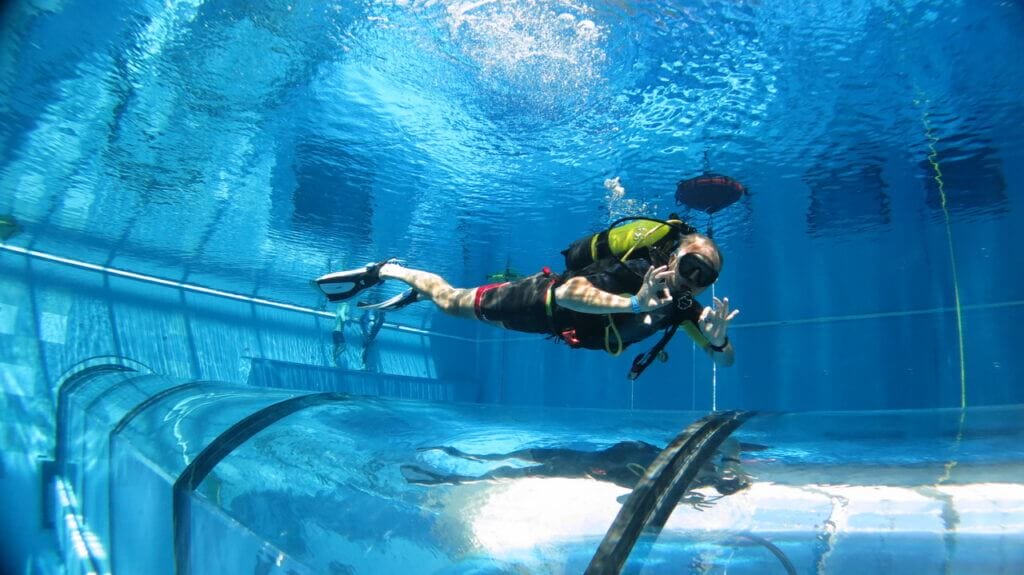
Preparing the equipment before the first pool
After the online training, the instructor arranges with us for the first practical exercises in the pool. We will meet him in front of the Deepspot reception and together fill out the relevant documents if we have not done so before. Then a brief discussion, change in the locker rooms and we gather on the pool deck. To begin with, we learn about the equipment seen earlier in the video. The instructor will explain to us how to choose the right equipment sizes and then under his supervision we will assemble our equipment. Such self-assembly of the equipment before the dive and disassembly after the dive means that in the future we will know how to do it ourselves. On diving trips, no one will twist our equipment.
In Deepspot, preparing for a dive is so convenient that all the equipment is gathered for us near where we enter the water. Diving cylinders are brought in on special carts. Overall it’s easy, nice and pleasant which can lull our vigilance a bit. In the future, at various dive sites and bases, we carry a bit of equipment (but you can always ask to carry the heaviest equipment, i.e. a diving cylinder). After preparing the equipment, we put it in the water, enter the pool and perform the first dressing of the equipment in the water. In the water, it is easier to dress the equipment as well as fit it.

First pool exercises
Now, under the supervision of an instructor, we are starting our first exercises. To begin with, we practice in completely shallow water in which we can freely stand on the bottom and breathe from the surface. However, it is so deep that if you kneel at the bottom of the pool you will be inches submerged.
To begin with, we will try breathing underwater. What is the basis of diving is also the simplest. We simply take a breathing machine to the mouth, exhale into it and breathe freely. The same on the surface as underwater. It doesn’t actually require any skills, although before you try to take the first few breaths it may cause some concern. From the automatic, breathing is completely natural and without any perceptible resistance. It’s certainly easier than breathing through a tube when snorkeling (if you’ve ever tried that).
I’d like to say about the next exercise, clearing the mask of water, too, that it’s simple – but it’s not. It is a rather mysterious exercise to which, depending on some corner of our psyche , people react differently. For some it is as easy as breathing for others it is very difficult. The exercise itself is to be able to empty the underwater diving mask of water if it pours there. It may pour by accident, due to inattention, or we may pour it specifically to rinse the inside of the glass from fogging.

The idea of clearing the mask of water, or so-called “mask blowout” is that you press the top of the frame surrounding the mask lightly against your forehead with your fingers and exhale with your nose into the mask. The exhaled air pushes the water out the bottom of the mask and the mask is emptied of water. The difficulty of this exercise is that as we pour water into the mask our nose is in the water. If the nose is in the water then, in some people, the body refuses to take an inhalation with the mouth from the automatic, but sends a signal to our brain that it is impossible to breathe and the diver “nudges”. This is just a mental reaction because, after all, the diver has the mouthpiece of the automat with air in his mouth all the time, but sometimes one side of the brain can’t convince the other and what will you do. Meaning in such a situation it takes a while to convince yourself that you can breathe freely with your nose in the water.
If we breathe freely, we will also exhale with our nose into the mask and clear it of water. Well, and that’s basically what this exercise is all about. Simply blowing out the mask is easy, but the point is that if such a situation of “chugging” of the diver after water poured into the mask occurred during the dive, it would be dangerous. However, if now in shallow water we knock over the fears and then repeat it a few more times, then in the future we will always feel that we can breathe despite the water in the mask and such a situation will not be a problem for us.
Ability to swim underwater
From the first immersions, we will also develop the ability to swim underwater. That we breathe freely is one thing, but efficient movement linked to maintaining zero buoyancy is equally important. Since we have fins on our legs, the basic swimming technique is legs to krabble and we try to keep our hands still (not waving them). If at the same time we are able to maintain neutral buoyancy then moving will be easy and efficient. Who wouldn’t want to stay as if in zero gravity? After all, future cosmonauts are just training underwater for future missions, because weightlessness underwater resembles that in space. If we master the maintenance of zero buoyancy, we will be able to change depth freely and move efficiently at a given depth and change depth easily or ascend efficiently.

Depths of dives on the course
During the training, we will practice the first skills at a depth of 1.5 meters so that we can get up at any time. After that, we will master more and more profound skills. Successively we will dive and practice at 3 meters, then 5-6 meters to later dive to 12 and finally 18 meters. These deeper dives, controlled descent and hovering above the water’s depths, will give us an incredible feeling of weightlessness. With subsequent entries into the water, there will be less and less exercise and more swimming, changes in depth, floating in the depths. Slowly we are beginning to pay attention to our surroundings and partners and not just ourselves and the instructor. We will begin to become real divers.
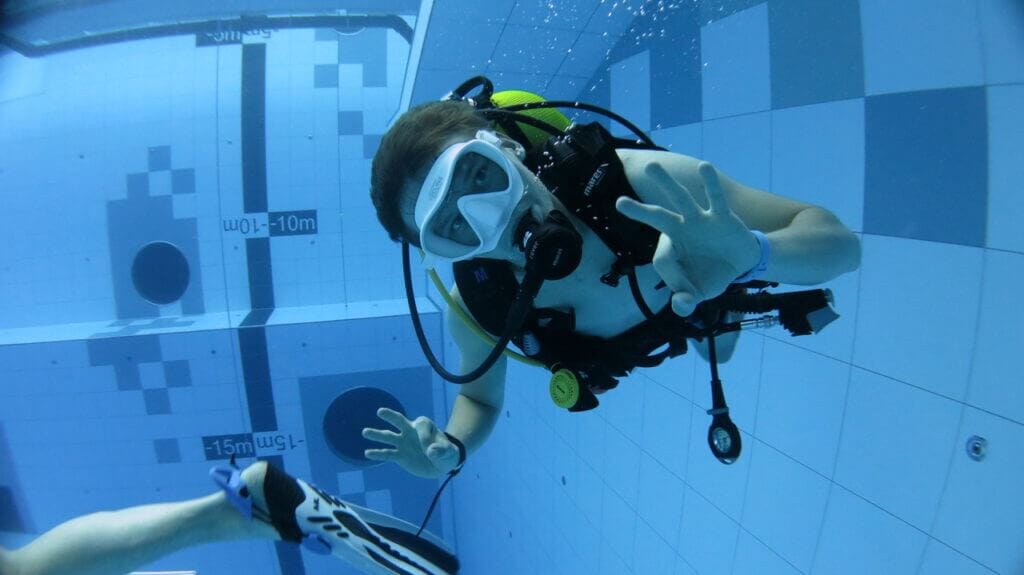
Practice emergency situations
The OWD course also involves practicing emergency situations and skills to help our partner underwater or on the surface. We will learn how to use a partner’s spare machine or how to ascend together with a partner while breathing from one cylinder (should one partner run out of air). These are situations that are very rare in practice. Most divers have never experienced such a situation in their diving careers. However, since this can happen, we learn how to handle ourselves or help our partner in such difficult situations as well.
Eligibility and opportunities for continuing training
The full OWD PADI course requires, in addition to dives in Deepspot, the completion of two dives in open water, that is, in typical lake or sea conditions. Immediately after passing the dives in Deepspot, we become authorized to dive up to 18 meters in Deepspot and up to 12 meters in open water (under the supervision of a guide).
After completing two additional dives in open water, one obtains full privileges under the OWD course, that is, the ability to dive with a partner up to 18 meters in open water.
